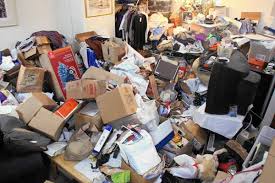A look at the psychology behind compulsive hoarding.

Jason Brien.
Compulsive hoarding is a mental health condition recognised by the DSM-5. Hoarding disorder extends well beyond the scope of typical collecting. Collectors often have very specific preferences (model trains/cars, posters, stamps, coins, etc) and they rarely collect items not related to their preference. People with hoarding disorder however are not specific. They will collect anything which to them has meaning. A person with hoarding disorder not only collects items, they are unable or unwilling to discard items.
A collector is often willing to trade or sell or throw away ‘extras’ or ‘doubles’ within their collection. Likewise, a collector might be persuaded by loved ones or family members to give away or sell all or part of their collection when the collection begins to take up too much living space or otherwise becomes of inconvenience. Compared to a compulsive hoarder, a collector is much more flexible and have the potential to readily detach from their collection when the need arises. A person with hoarding disorder however is very, very reluctant to discard anything at all. A hoarders’ collection will occupy all possible living spaces and can quickly become a health and fire hazard.
It can be hard for a non-hoarder to understand a compulsive hoarders’ behaviours, feelings and thoughts. To an outsider, the hoarder’s ‘collection’ resembles trash, garbage or just a random collection of useless items. It can be extremely difficult for outsiders to understand the connection the hoarder has to their collection. For the hoarder, each item has an attached value or meaning. The hoarder attaches a pathological sentimental value to each of the items they collect. A piece of paper with notes written on it may hold the same sentimental value to a hoarder as a priceless piece of jewellery handed down through generations does to the average person.
Compulsive hoarders can use their collections to reduce anxiety (in life in general not reduce anxiety related to their condition) and provide a sense of safety. Some researchers and theorists suggest that the vast collections provide the compulsive hoarder with a buffer zone so to speak. That is, the collections provide a physical barrier between people and the hoarder thus making it harder for people to get physically close to the hoarder. Some compulsive hoarders engage in Anthropomorphism – they attach human qualities to the collected items and can therefore be reluctant to discard items because the items would then not have a ‘home’ or they would become ‘lonely’ if thrown away.
Compulsive hoarding is not necessarily related to obsessive-compulsive disorder (OCD). Compulsive hoarding can only fit within the spectrum of OCD when it is egodsytonic (causes the person significant stress and distress), the collecting is aimed at reducing or eliminating unwanted thoughts or behaviours, the person shows no interest in the items collected or they compulsively collect highly specific items. The brains of compulsive hoarders are also different from people diagnosed with OCD and as such they will not always respond well to treatment options designed specifically to treat OCD.
Additionally, people diagnosed with OCD generally have greater insight into their condition compared to compulsive hoarders. A person with OCD is MORE likely to seek help than a person with hoarding disorder. Furthermore, the compulsive behaviours characteristic of OCD is negatively reinforced by avoidance (avoiding unwanted thoughts, fear, anxiety, etc) but there is no positive reinforcement of OCD symptoms (the symptoms are not desired in anyway). Compulsive hoarders experience both negative reinforcement (by avoiding having to discard items) and positive reinforcement (through the pleasure associated with collecting and through attaching special meaning to each item collected).
Some research has suggested that compulsive hoarding may be the result of deficits in executive functioning. Executive functioning is related to flexible thinking, planning, self-monitoring, self-control, working memory, time management, and organization. Other researchers and theorists have suggested that the collected items are perceived, by the hoarder, as an extension of their self and identity in a similar manner to the way a collector’s collection is an extension of themselves and their identity or the style of clothing is an extension of identity to the average person.
The families and loved ones of compulsive hoarders often suffer the most from the condition. The families and loved ones often lack true knowledge and understanding of the condition and they can therefore struggle to assist the compulsive hoarder. Whilst the family and loved one’s act with the best intentions, cleaning and throwing away items can cause the hoarder great stress and distress. The hoarder can mourn the loss of ‘loved’ items for long periods of time or may go to great lengths to try and recover or retrieve the discarded items.
Compulsive hoarders will not seek therapy willingly but therapy is generally the best course of action. Therapy can last a long time without much progress being achieved which frustrates family and loved ones. The therapist must work closely with the hoarder and help the client detach from their collected items. Cognitive behaviour therapy has worked reasonably well in the treatment of compulsive hoarding. Medications can help to reduce and alleviate the accompanied anxiety associated with discarding items but there is no medication specifically designed to treat compulsive hoarding.
Resources.
https://www.psychiatry.org/patients-families/hoarding-disorder/what-is-hoarding-disorder